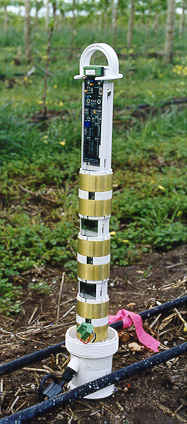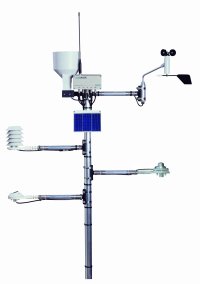Irrigation Planning & Management
The rule of thumb
What's the most widely used rule to determine irrigation
practice? The rule of thumb. Not quite adequate any more,
one is tempted to say. Today's irrigation needs go way
beyond pouring water on plants. Who irrigates properly can
largely influence
- crop yield and quality,
- the effectiveness of fertilizers,
- soil salinity and oxygen content,
- balance of micro-organisms,
- a water bill,
- life span of pumps and equipment,
To achieve the above one will need not
only solid Know-How, but also the proper tools to find out
what's right and what's wrong. We Have developed efficient
decision support systems, dedicated to supply irrigation
managers with the data they need.
Soil moisture vs.
ETo?
Arguments can be made for either. There are Pro's and Con's
for both methods. You can have either one, be it a single
point or a multi-level soil measurement site or a
professional ET station - or both!
What is it that
matters? 
Soil and crop are closely linked to each other in a
dynamic, permanently changing relation. The needs of an
emerging plant on soil still soaked from snow melt is
entirely different from the needs of that very same plant
on a hot and dry day in late August, prior to harvest.
Irrigating all season following the same pattern is rather
not recommended and can lead to very undesirable
results.
What are some of the key
elements that need to be taken into
consideration?
- Which types of soil am I dealing with?
- How much water can these soils hold?
- How much water do my crops need in their respective
phenological phases?
- How deep down are the active root zones of my
crops?
- Which effect does dry stress have on my crops?
- When and how do I need to fertilize/fertigate?
Given the above it becomes obvious that
every crop, every pheno-phase, every soil type and every
terrain have their own specific requirements, and that
uniform application of irrigation no matter when and where
can't be the solution.
Probably the most irrigation research
was done in viticulture, which is easy to explain: even
seemingly small errors can have tremendous effects, making
all the difference between premium wine and plonk.
Viticulture has also created many irrigation experts,
mastering the most difficult and demanding irrigation
techniques, like "controlled deficit irrigation"
and "partial root zone drying", thus determining
color and taste, sugar contents and pulp.
How can technology help?
Every irrigation management decision is based on lots of
data. Data that needs to be accurate, reliable and readily
available in almost real time. From every site, every crop,
every micro climate. With the data coming to the grower,
and not the other way round.
What are the advantages of a
Continious Monitoring solution?
- get site specific soil and weather data in almost
real time
- monitor soil moisture in various levels of the soil
profile with a large variety of soil moisture
sensors
- monitor water uptake
- monitor the efficiency of your irrigation
system
- calculate evapotranspir
ation
- access your data from anywhere and anytime through
internet based software with Wireless Device Access
service
The benefits at a glance:
- Get important data automatically and 24/7
- Irrigate only when and as much as necessary (can
save 50% of water and more!)
- Avoid over-irrigation and too much dry stress
- No wash-out of nutrients
- Irrigation corresponding to the respective
phenological phases
- Control your crops yield
- Control your crops quality
- Save time and money
- Operate environmentally friendly
- Make more profit!


